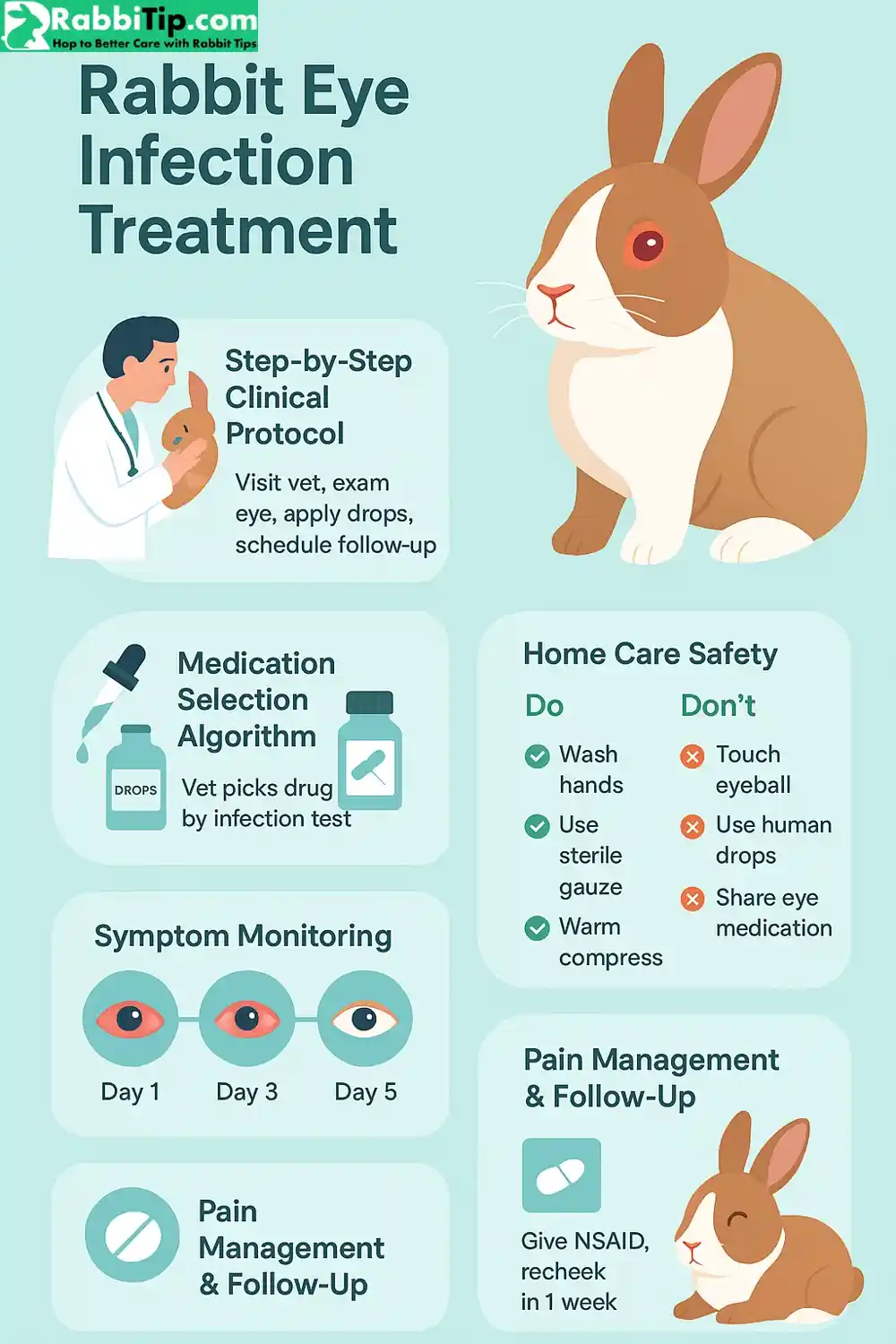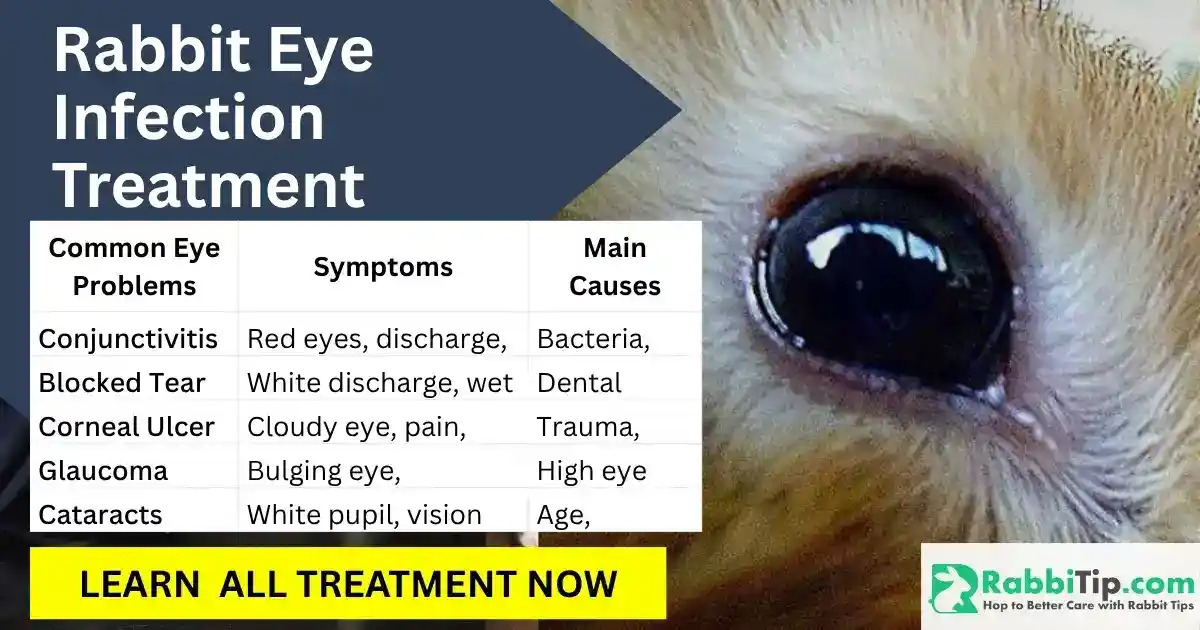Rabbit eye infection treatment requires prompt veterinary care and targeted therapy. Catching an eye infection early helps stop pain and vision loss. This guide uses American College of Veterinary Ophthalmologists (ACVO) protocols, USDA-approved medication guidelines, and evidence-based treatment timelines. We follow ACVO guidelines, USDA dosing charts, and timelines that studies have shown work best for rabbits. With proper care, most cases heal in 7–14 days.
Watch for severe signs like fast swelling, pus, pain, or closed eyes. Dental disease links to eye issues in rabbits. White discharge often means blocked tear ducts or infection. Emergency signs include sudden blindness, severe swelling, or blood in the eye. Common Eye Problems In Rabbits include Conjunctivitis, Dacryocystitis, Corneal ulcers, Glaucoma, Cataracts, and blocked tear ducts. Early treatment can protect sight.
Common Rabbit Eye Problems – Symptoms and Causes
Rabbit eye problems range from mild irritation to serious infections. Early recognition saves vision and prevents complications. Most issues start small but grow worse without treatment.
Key warning signs include:
- Red, swollen eyelids
- Cloudy or white discharge
- Excessive tearing
- Squinting or keeping eyes closed
- Scratching at the eye area
| Common Eye Problems | Symptoms | Main Causes |
|---|---|---|
| Conjunctivitis | Red eyes, discharge, swelling | Bacteria, dust, allergies |
| Blocked Tear Ducts | White discharge, wet face | Dental problems, genetics |
| Corneal Ulcer | Cloudy eye, pain, blinking | Trauma, infection, dry eye |
| Glaucoma | Bulging eye, blindness | High eye pressure |
| Cataracts | White pupil, vision loss | Age, genetics, and diabetes |
Rabbit Eye Infection Treatment
Step-by-Step Clinical Protocol
Initial Assessment (Day 1)
- Check both eyes for discharge color and amount
- Look for swelling, redness, or cloudiness
- Test vision by waving a hand near the rabbit’s face
- Note any head tilting or balance problems
- Document symptoms with photos if possible
Veterinary Diagnosis (Day 1-2)
- Culture discharge to identify bacteria
- Stain the cornea to check for ulcers
- Measure eye pressure for glaucoma
- X-ray skull if dental disease suspected
- Blood tests for systemic illness.
Medication Selection Algorithm: Primary antibiotics for rabbit eye infections:
- Chloramphenicol – first choice for most bacteria
- Ciprofloxacin – for resistant infections
- Gentamicin – for severe cases only
- Tobramycin – an alternative to gentamicin
Home Care Safety Framework
DO:
- Wash your hands before touching the rabbit
- Use separate tissues for each eye
- Give medicine at the same time daily
- Keep the rabbit in a clean, dust-free area
- Monitor appetite and behavior
DON’T:
- Use human eye drops
- Touch the medicine tip to the eye
- Stop treatment early
- Let other pets near the infected rabbit
- Use cotton swabs on the eyes
Symptom Progression Monitoring
Days 1-3: Discharge may increase initially.
Days 4-7: Swelling should start reducing.
Days 8-14: Clear improvement expected.
After 14 days: Most infections resolve completely.

Dacryocystitis Diagnosis and Treatment in Rabbits
Dacryocystitis means inflammation of the tear ducts. This condition blocks normal tear drainage and causes sticky discharge. Treatment urgency depends on severity, but most cases need immediate care. The infection can spread to surrounding tissues if left untreated.
Antibiotic Efficacy Matrix
| Infection Type | First Choice | Success Rate | Treatment Days |
|---|---|---|---|
| Bacterial conjunctivitis | Chloramphenicol | 85-95% | 7-10 |
| Dacryocystitis | Ciprofloxacin | 70-80% | 14-21 |
| Mixed infection | Combination therapy | 60-75% | 14-28 |
Treating Conjunctivitis
Conjunctivitis is the most common rabbit eye problem. The clear membrane around the eye becomes red and swollen. Treatment focuses on reducing inflammation and fighting infection. Most cases respond well to topical antibiotics within one week.
Ointment vs Drops Comparison
| Formulation | Best Use Case | Application Frequency | Pros | Cons |
|---|---|---|---|---|
| Ointment | Severe infections | 2-3 times daily | Longer contact time | May blur vision |
| Drops | Mild infections | 3-4 times daily | Easy application | Washes out quickly |
| Gel | Moderate cases | 2 times daily | Good coverage | More expensive |
How to Give Eye Medication to Rabbits
Proper medication technique ensures treatment success. Wrong application can harm the eye or stress the rabbit. Most rabbits need gentle restraint during treatment. The key is staying calm and moving slowly.
Step-by-Step Guide to Giving Eye Medication to Rabbits
- Sit rabbit on lap
- Hold head gently
- Pull lower lid
- Apply drop or ointment strip
- Let rabbit blink to spread
Home Treatment Safety Guide
| Method | Risk Level | Veterinary Approval | Notes |
|---|---|---|---|
| Saline rinse | Low | Always approved | Use only sterile saline |
| Antibiotic drops | Medium | Prescription required | Follow exact dosing |
| Warm compress | Low | Usually approved | Test the temperature first |
| Cotton cleaning | Medium | With proper technique | Never use cotton swabs |
Rabbit Eye Infection White Discharge Treatment
White discharge usually means bacterial infection. The thick, creamy fluid contains white blood cells fighting germs. This type of discharge needs antibiotic treatment and cannot heal on its own. Color changes help track treatment progress.
Treatment steps for white discharge:
- Clean discharge gently with warm saline
- Apply the prescribed antibiotic ointment
- Monitor discharge color and amount daily
- Continue treatment for the full prescribed course
- Return to the vet if discharge worsens
Best Eye Drops for Rabbits
Not all eye drops work safely in rabbits. Human products can cause serious harm or death. Only use veterinary-approved medications designed for rabbits or small animals.
Safe Options (Prescription Only):
- Chloramphenicol drops – broad-spectrum antibiotic
- Ciprofloxacin drops – for resistant bacteria
- Artificial tears – for dry eyes only
- Prednisolone drops – anti-inflammatory (vet supervised)
Never Use:
- Visine or similar human drops
- Drops with preservatives
- Steroid drops without antibiotic
- Expired medications
Rare Eye Conditions in Rabbits
Some eye problems occur less commonly but need special care. These conditions require specialist veterinary treatment and may cause permanent vision changes.
- Glaucoma – High pressure inside the eye causes blindness
- Uveitis – Inflammation inside the eye, very painful
- Cataracts – Lens becomes cloudy, blocking vision
- Corneal dystrophy – Genetic clouding of the cornea
- Retinal disease – Back of eye damage, rare
When to Contact Your Vet
Some symptoms need immediate veterinary care. Waiting can mean permanent vision loss or life-threatening complications. Trust your instincts – if something seems wrong, call your vet.
Emergency Signs:
- Sudden vision loss or blindness
- Eye bulging out of the socket
- Blood in or around the eye
- Severe pain (grinding teeth, hiding)
- Not eating or drinking
Same-Day Appointment Needed:
- New discharge or worsening symptoms
- The eye is staying closed all day
- Cloudiness in the clear part of the eye
- Scratching at the eye constantly
Home Remedies and Natural Care
Some gentle home care can support veterinary treatment. However, natural remedies cannot replace proper medical care for infections. Always check with your vet before trying home treatments.
Safe Supportive Care:
- Keep the living area very clean
- Remove dust and strong scents
- Provide extra water and favorite foods
- Use an air purifier to reduce irritants
- Give a quiet, stress-free environment
Safe at-home aids:
- Warm, damp compress
- Clean with sterile saline
- Calm environment
- Soft bedding
Costs: Saline is low-cost. Vet exams, tests, and antibiotics vary.
What NOT to Try:
- Tea bags on the eyes
- Essential oils near the face
- Herbal rinses
- Honey or other food items
- Human medications
Cost of Rabbit Eye Treatment
Eye infection treatment costs vary by location and severity. Early treatment costs less than advanced cases. Most rabbit owners spend between $100-300 for complete treatment.
Typical Costs:
- Initial vet exam: $50-80
- Eye medications: $20-50
- Follow-up visit: $30-50
- Tear duct flush: $100-200
- Surgery (if needed): $300-800
Many vets offer payment plans for expensive treatments. Pet insurance may cover some costs if you have a policy before problems start.
Final Words
Rabbit eye infection treatment success depends on fast action and proper care. Early signs like red eyes, white discharge, or squinting need quick vet attention. Most infections heal well with the right antibiotics and home support care. Never try to treat serious eye problems at home alone.
The key to good results is working with your vet. They can pick the best medicine for your rabbit’s specific infection. Follow all treatment steps exactly as prescribed. Keep your rabbit’s area clean and dust-free during healing.
Watch for emergency signs like sudden blindness or severe pain. These need immediate vet care. Most rabbit eye infections clear up in 1-2 weeks with treatment. Good care now prevents bigger problems later.
Your rabbit depends on you to spot problems early. Quick rabbit eye infection treatment saves vision and keeps your bunny healthy and happy for years to come.
For Rabbit Respiratory Infection Treatment:
Learn safe, vet-approved steps for rabbit respiratory infection treatment.
For Rabbit Diarrhoea Treatment:
Find quick, clear tips for rabbit diarrhoea care and recovery.
FAQ-Rabbit eye infection treatment
How to treat a bunny eye infection at home?
You cannot safely treat rabbit eye infections at home without veterinary medicine. Clean discharge gently with sterile saline, but infected eyes need prescription antibiotics. Home remedies can make infections worse and cause permanent damage.
What antibiotics are used to treat rabbit eyes?
Veterinarians commonly prescribe chloramphenicol, ciprofloxacin, or gentamicin for rabbit eye infections. The choice depends on the type of bacteria causing infection. Never use leftover antibiotics or human medications.
What causes an eye infection in rabbits?
Bacteria, blocked tear ducts, dental disease, and environmental irritants cause most rabbit eye infections. Dusty bedding, poor ventilation, and trauma can trigger problems. Some rabbits have genetic tendencies toward eye issues.
What eye drops are good for rabbits with conjunctivitis?
Only veterinary-prescribed eye drops work safely for rabbit conjunctivitis. Chloramphenicol drops are most commonly used. Human eye drops contain ingredients that can poison rabbits or make infections worse.
Can an eye infection kill a rabbit?
Severe eye infections can spread to the brain or cause life-threatening complications. Rabbits that stop eating due to pain can develop deadly digestive problems. Early treatment prevents the most serious complications.
Important Note: This guide provides educational information only. Always consult with a qualified veterinarian for diagnosis and treatment of rabbit eye problems. For emergency veterinary care near you, visit our rabbit vet finder tool. Download our free bunny care sheet for additional rabbit health resources.
Learn more about common rabbit diseases and prevention strategies on our comprehensive health guide.

